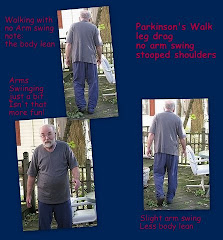
We've concentrated on getting the diaphragm involved in the breathing pattern because many Parkinson's patients don't use their diaphragms much. It is the diaphragm which is so vital to allowing the lungs to expand to inhale. Even more important is its role in the exhale, forcing out as much of the old air, clearing the lungs to make room for fresh air.
It is always a good practice to stretch your spine before breathing exercises.
 |
| Stretching first adjusts posture and opens the chest area |
Inhalation stimulates-revitalizes the system-fills the lungs.
Retention raises the internal temperature and increases the absorption of oxygen
Exhalation allows the diaphragm to return to a normal position which helps the rib cage to contract, expelling impurities.
One of the problems with not breathing "properly" is that we go into panic
 mode which often traps air in the lungs, a condition known as hyperinflation. To fight this we try to breathe faster possibly gulping for air which results in more inflation and more trapped toxic air. We feel worse, not better - causing more panic and the vicious cycle worsens. Yoga is not just the body, the exercises are to help you find a better place - to release the fear. Close your eyes, exhale, be the exhale.
mode which often traps air in the lungs, a condition known as hyperinflation. To fight this we try to breathe faster possibly gulping for air which results in more inflation and more trapped toxic air. We feel worse, not better - causing more panic and the vicious cycle worsens. Yoga is not just the body, the exercises are to help you find a better place - to release the fear. Close your eyes, exhale, be the exhale.If you are not using soothing music, you can clear your head or find a peaceful image which allows you to be...
From Hatha Yoga - The Exhale - Diaphragm, Rib Cage, Upper Thoracic/Clavicular
Although most effectively performed when you are prone, you can also remain seated.
1) Empty the lungs as much as possible.
2) Slowly lower the diaphragm allowing air to enter the lungs.
Once the abdominal area swells filling the bottom of the lungs with air...
3) Expand the ribs without straining, then
4) Allow the lungs to completely fill by raising the collar-bones
The entire process is smooth and silent, no pauses, no noise
5) The exhale is the same sequence allowing
6) The diaphragm now forces the air from the lungs
7) As the rib cage contracts
8) And the chest naturally falls back in on itself
 We will explore utilizing Pranayama for depression on another day.
We will explore utilizing Pranayama for depression on another day.Meanwhile, remember that Yoga breathing exercises are also helpful for Parkinson's constipation
Take 2 normal breaths
Exhale
And then see how long you can Hold Your Breath.
The goal is 60 seconds.
Helpful hint: if your nasal passages are blocked, try pinching your nostrils together for a few seconds. If that doesn't work, try gently pinching above the bridge of your nose (top of the eye sockets) with the thumb and middle finger of one hand while pressing the depression above your lips/below your nose. Gently hold. Release. Repeat.
Shallow BreathingBreathe through your nose - only your nose - for 5 minutes
Take shallow breaths - keep your mouth shut
Then take the Control Pause Breathing Test again to see if you have improved.
Put it Together
Repeat the Test - Shallow Breath - Test sequence 4 or 5 times in a row.
Repeat this training session 3 or 4 times a day - every day for a week.
You may miss a session here or there, don't worry about it.
The goal is to increase your Control Pause
After a week you should be able to exhale and hold your breath for at least a 60 second count.
9-19-2011 Addendum
If you need additional help for developing breath stamina:














This is great information. I have always thought I was breathing correctly during meditation but I realize now that I wasn't going through the full process correctly. Thank you for the information and I look forward to future posts.
ReplyDelete